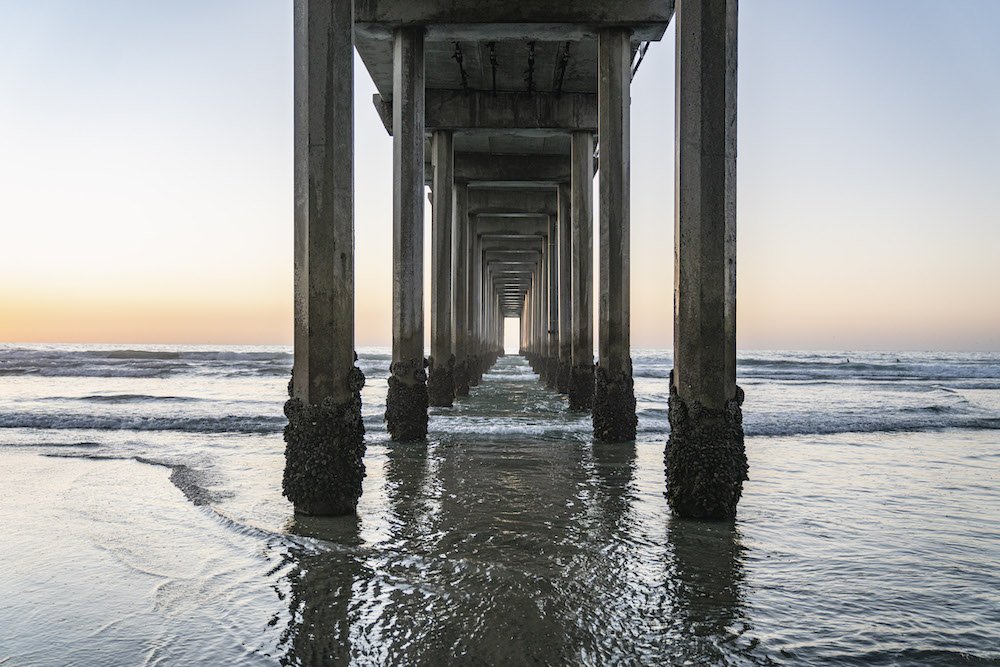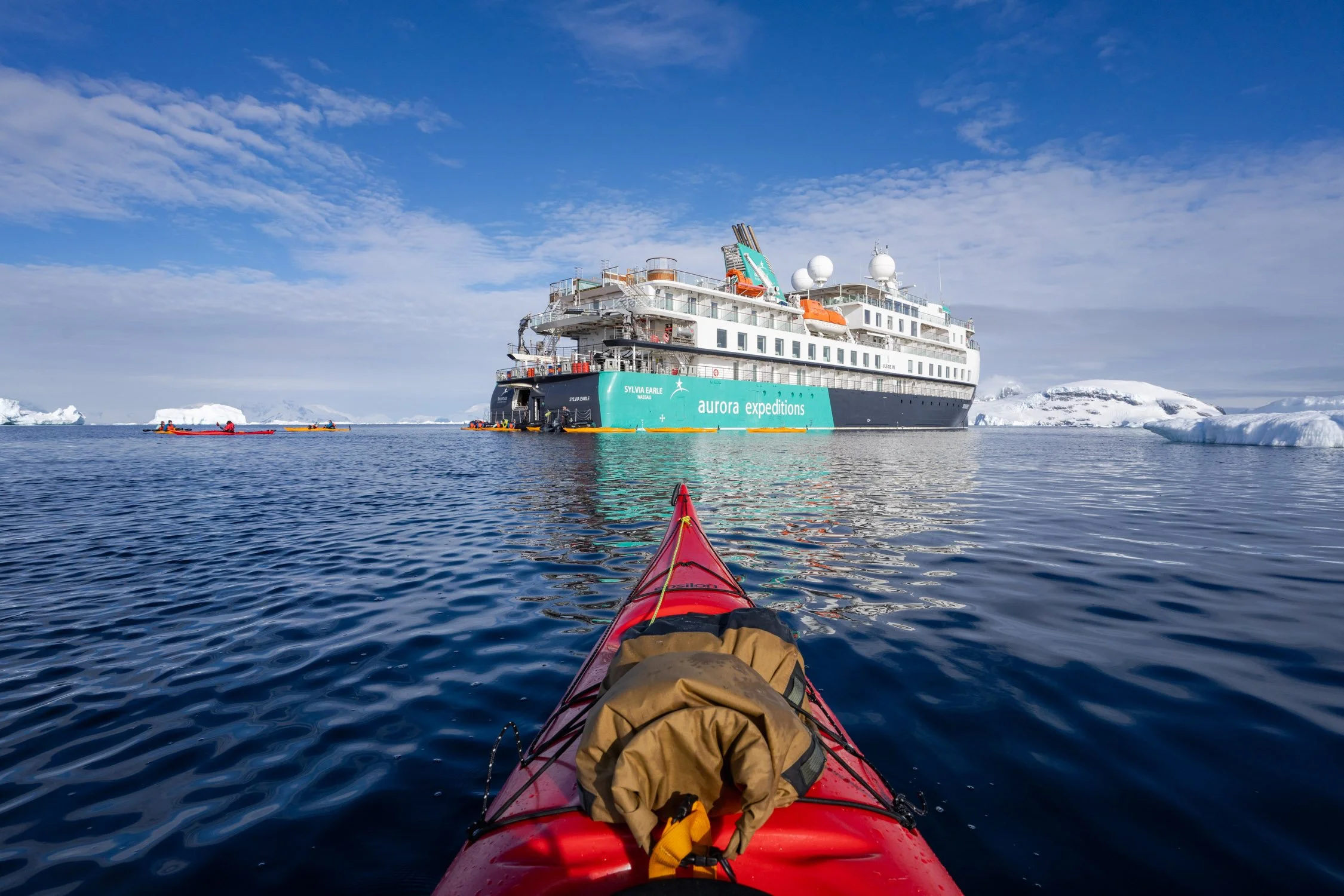The Wildlife I Saw on an Antarctica Cruise Blew Me Away, But Not Why You Think
Antarctica, the southernmost continent, is one of the most remote and pristine places on Earth. Its icy wilderness and surrounding seas are home to a unique array of wildlife that you won't find anywhere else. Setting sail on an Antarctica cruise offers the opportunity to witness these incredible animals in their natural habitat up close and personal. Here, we'll explore the common wildlife you can expect to see, the best times of year to spot each species, what to expect on your journey, and some important guidelines to follow to ensure the safety and preservation of this delicate environment.
A humback whale taking breath while kayakers enjoy a front row seat. Photo by Dalton Johnson
Common Wildlife in Antarctica
1. Penguins
Penguins are perhaps the most iconic residents of Antarctica. There are several species you might encounter:
Emperor Penguins: The largest of all penguin species, Emperor Penguins are known for their remarkable breeding cycle. They lay their eggs during the harsh Antarctic winter, with males incubating the eggs on their feet.
Adélie Penguins: Small and feisty, Adélie Penguins are often seen in large colonies along the Antarctic coast. They are excellent swimmers and can often be seen diving for krill.
Gentoo Penguins: With their distinctive white stripe above the eye and bright orange beak, Gentoo Penguins are easily recognizable. They are known for their playful behavior and curiosity towards humans.
Chinstrap Penguins: Named for the thin black line under their heads that looks like a helmet strap, Chinstrap Penguins are often found on rocky islands and are highly social.
2. Seals
Antarctica is home to several species of seals, each with unique characteristics:
Weddell Seals: Known for their ability to dive to great depths, Weddell Seals are often seen lounging on the ice. They have a placid nature and are known for their melodic underwater vocalizations.
Leopard Seals: These apex predators are distinctive for their long, muscular bodies and large, reptilian heads. They are solitary hunters, primarily preying on penguins and other seals.
Crabeater Seals: Despite their name, Crabeater Seals primarily eat krill. They have specialized teeth that allow them to filter these tiny crustaceans from the water.
Elephant Seals: The largest of all seal species, male Southern Elephant Seals are known for their massive size and distinctive trunk-like noses. They are often seen during the breeding season, battling for dominance on the beaches.
3. Whales
The waters surrounding Antarctica are rich feeding grounds for various whale species:
Humpback Whales: Known for their acrobatic breaches and complex songs, Humpback Whales are a common sight in Antarctic waters during the feeding season.
Minke Whales: These smaller baleen whales are curious and often approach ships, giving passengers a close-up view.
Orcas (Killer Whales): These highly intelligent and social predators can be seen hunting in packs. They are known for their striking black and white coloration and complex behaviors.
Blue Whales: The largest animals on Earth, Blue Whales can sometimes be spotted feeding on krill in Antarctic waters.
4. Birds
Apart from penguins, several seabird species are commonly seen:
Albatrosses: With their impressive wingspans, albatrosses are a magnificent sight. The Wandering Albatross, in particular, is known for its massive wingspan, which can reach up to 11 feet.
Petrels: These seabirds, including the Giant Petrel and the Snow Petrel, are often seen gliding over the waves or resting on the ice.
Skuas: Aggressive and opportunistic, skuas are often seen around penguin colonies, where they prey on eggs and chicks.
Best Time to See Wildlife in Antarctica
The Antarctic cruise season typically runs from November to March, during the Southern Hemisphere's summer. The best time to see wildlife varies slightly depending on the species:
November to December: Early in the season, the ice begins to break up, and penguins return to their breeding colonies. This is the best time to see courtship displays and nest building. Seals also start to haul out onto the ice to give birth.
January to February: This is the height of the Antarctic summer, with longer days and more activity. Penguin chicks hatch and are fed by their parents. Whale sightings become more frequent as they come to feed on krill.
March: As the season winds down, penguin chicks begin to fledge, and many seals start to molt. Whales are still abundant, taking advantage of the rich feeding grounds before heading to warmer waters.
Related Read: BEST TIME TO VISIT ANTARCTICA ON A CRUISE SHIP
What to Expect on an Antarctica Cruise
An Antarctica cruise is an adventure like no other. Here’s what you can expect:
Expedition Ships: Cruises are typically conducted on specially designed expedition ships that can navigate the icy waters safely. These ships are equipped with Zodiacs (small inflatable boats) for shore landings and close-up wildlife encounters.
Guided Excursions: Experienced guides and naturalists lead daily excursions, providing insights into the region's wildlife, geology, and history.
Educational Programs: Onboard lectures and presentations enhance your understanding of Antarctica’s unique ecosystem.
Strict Guidelines: To protect the fragile environment, strict guidelines are followed. Passengers must disinfect their boots before and after each landing, and there are limits on the number of visitors allowed at each site.
What You Can’t Do in Antarctica
To preserve Antarctica’s pristine environment, several rules must be followed:
No Disturbing Wildlife: Maintain a safe distance from all wildlife. Do not touch, feed, or approach animals too closely.
No Littering: All waste must be carried back to the ship. This includes even small items like cigarette butts or food scraps.
No Collecting Souvenirs: Do not take anything from the environment, including rocks, feathers, or plants.
No Smoking: Smoking is generally prohibited during landings and only allowed in designated areas on the ship.
Stay on Designated Paths: Follow marked paths and stay within the designated visitor areas to minimize environmental impact.
A fur seal poses atop a rock for the camera. Photo by Dalton Johnson
Frequently Asked Questions (FAQs)
1. How close can I get to the wildlife?
While it may be tempting to get as close as possible to Antarctica’s unique wildlife, strict guidelines are in place to ensure their safety and yours. The International Association of Antarctica Tour Operators (IAATO) recommends maintaining a distance of at least 5 meters (15 feet) from all wildlife. For larger animals like seals, a distance of 15 meters (45 feet) is advised. It's crucial to remember that these are wild animals, and close encounters can cause them stress or provoke defensive behaviors. Guides will enforce these rules and provide instructions on how to approach wildlife respectfully and safely.
2. What type of clothing should I pack for an Antarctica cruise?
Packing for an Antarctica cruise requires careful planning. Layers are key to staying warm and comfortable. Start with a moisture-wicking base layer, add an insulating mid-layer, and top it with a waterproof and windproof outer shell. Essentials include thermal underwear, fleece or down jackets, waterproof pants, gloves, a hat, and a neck gaiter. Don’t forget high-quality, insulated boots suitable for walking on ice and snow. Sunglasses and sunscreen are also important, as the sun’s reflection on the ice can be intense. Most expedition companies provide a packing list to ensure you have everything you need.
3. How do I avoid seasickness on the Drake Passage?
The Drake Passage, the body of water between the southern tip of South America and Antarctica, is known for its rough seas. To minimize the risk of seasickness, choose a lower, central cabin where motion is less pronounced. Over-the-counter medications like meclizine (Bonine) or dimenhydrinate (Dramamine) can help, as can prescription options like scopolamine patches. Acupressure wristbands and ginger supplements are alternative remedies some travelers find effective. Stay hydrated, avoid alcohol and heavy meals, and spend time on deck for fresh air and to keep your eyes on the horizon.
4. Are there any age restrictions for Antarctica cruises?
Age restrictions for Antarctica cruises vary by operator. Many expedition companies recommend a minimum age of 8 to 10 years old due to the physically demanding nature of excursions and the harsh environment. Elderly passengers must consider their physical fitness, as landings often involve walking on uneven, icy terrain and climbing in and out of Zodiacs. Some cruises offer special family-friendly departures with activities tailored to younger travelers, while others may have more stringent age and health requirements. Always check with your tour operator for specific age guidelines.
5. What kind of camera equipment should I bring?
Antarctica offers unparalleled photo opportunities, so bringing the right camera equipment is essential. A DSLR or mirrorless camera with a range of lenses, from wide-angle for landscapes to telephoto for wildlife, is ideal. A sturdy tripod is useful for steady shots, especially in low light conditions. Extra batteries and memory cards are a must, as cold temperatures can quickly drain battery life. Waterproof and protective gear for your camera is also important to safeguard against the elements. A polarizing filter can help reduce glare from the snow and ice, enhancing the quality of your photos.
My Recommendations:
6. Can I visit Antarctica independently?
Visiting Antarctica independently is not feasible, for the average boater, due to its remote location, harsh conditions, and strict environmental regulations. The Antarctic Treaty System regulates all human activity on the continent to protect its unique ecosystem. As a result, all visitors must travel with an approved tour operator that follows the guidelines set by the International Association of Antarctica Tour Operators (IAATO). These operators provide the necessary expertise, equipment, and permits to ensure a safe and environmentally responsible visit. Solo travel is not permitted, and all activities are conducted under the supervision of experienced guides.
An Adélie Penguin waddles along the rocks headed for the water. Photo by Dalton Johnson
An Antarctica cruise is a once-in-a-lifetime experience that offers the chance to see some of the most incredible wildlife on the planet. From the playful antics of penguins to the majestic presence of whales, the variety of animals you can encounter is astounding. By understanding the best times to visit, knowing what to expect, and following the guidelines to protect this pristine environment, you can ensure a memorable and respectful journey to the White Continent.










